
Australia So Much to See

A.
NO and yes.
No, you cannot stop just anywhere on the side of the road to camp. When you go inland where distances
between towns are great, nobody minds you stopping overnight if no trace is left behind. See Responsible Camping.
Long inland roads often have roadside rest areas for overnight stays, and some of these have a 'pit' (no water) toilet. Generally around the coast camping is not permitted anywhere outside of caravan parks and designated campgrounds. To the left we are at a Main Roads WA 24 hours rest area north of Newman on the Great Northern Highway. The rest area is well away from the highway and there is a pit toilet. The rest area to the right is at Lake Johnston, a large salt lake between Norseman and Hyden in Western Australia.
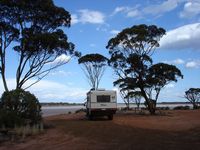
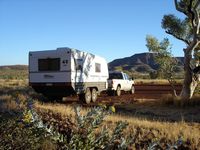
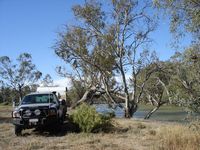
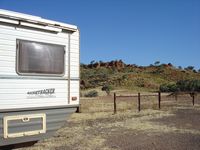
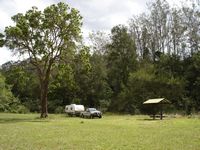
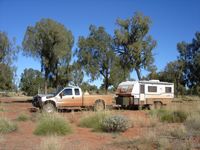
Travelling on the Stuart Highway through the Northern Territory for example, there are a number of roadside rest areas, and in tourist
season these fill early in the afternoon. Most highway rest areas in the Northern Territory are 24 hour rest areas with camping
permitted. They are also close to the highway so you get traffic noise. We have found a number of other places to get
further away from the road and have had these to ourselves or perhaps one other camper but you need to know how to find these.
You are not permitted to camp in a nature reserve unless there is a campground provided. In most National Parks, you may only
stay in the campgrounds, and fees may be charged.
When you have a Permit to travel through Aboriginal Lands
such as the Great Central Road your permit will specify that you can only camp in designated campgrounds, and that you may not divert from the road by more than thirty metres; that being the road reserve.All land is owned and/or managed by somebody, be it a privately owned farm, a leased pastoral station, or land owned by a Government
body for some purpose. Where possible, seek permission from the landholder. Never camp near water troughs or water sources
for animals. Do not use soap or detergents in or near water courses or water sources.
Safety: In choosing you campsite, be aware of Campsite Safety. Ensure that campfires are only lit in areas where it is permitted
and in safe weather conditions. Campfires are not permitted in many regions of Australia. Check the state fire services
links in the Campfire Safety article to read about fire regulations, fire ban seasons in regions, and days when a total fire
ban and movement of vehicles off road has been declared. Alerts for any major out of control bushfires will also be shown on
these websites.
For those of us with our onboard bathrooms, places we stop overnight can include disused roadworks gravel dump sites, abandoned roads
due to a road re-alignment, or tracks along the edge of rivers and streams, but not in Shires that prohibit camping outside of specified
areas, or near towns. These are not in places you would want to stay longer that an overnight rest while travelling though. Caravans often have a toilet and shower, otherwise travellers take a portable toilet and shower tent if they want to camp outside
of caravan parks.
Young travellers in campervans, in particular the cheaper hire ones without an onboard toilet, can be a problem to authorities and
communities. Some may not understand our regulations and camp in unsuitable places such as car parks near beaches, or stay for
a longer time in 24 hour only parking area. In the Western Australian popular holiday town of Broome there was a real problem
with young visitors in hire vehicles taking over the car park at Cable Beach and staying for weeks creating a “shanty town” look in
an area where camping is not permitted and the parking area is needed for day visitors to the beach. For those who refuse to
move or pay fines levied, the Council has started wheel clamping the vehicles until the fines are paid, and may impound the vehicle
if payment is not made. It is because of campers stopping in day only areas or for a longer time in short term parking that
some Councils have made very strict no camping rules.
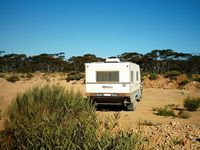
Option 1: Via Katoomba, Dubbo, Bourke, Charleville, Longreach, Mount Isa, Barkly Highway, Stuart Highway to Katherine, Victoria Highway and Great Northern Highway 5,211 kilometres. Full route
To right: Highway through Barcaldine and Qantas musuem at Longreach
A The time of year may make a difference in your choice. If travelling in summer, the northern route will be hot and there is a possibility of cyclonic rains closing roads for short periods.
Please note that changes to Google maps has resulted in the routes I have described being altered when Google re-plots the routes when you click on the links.
Distances based on Google maps as per linked route plans are:
Option 3: Via Sturt Highway, Burra, Port Augusta, Kalgoorlie, Goldfields Highway to Meekatharra and Great Northern Highway 5,583 kilometres. Full route
This option incorporates around 180 kilometres of unsealed road between Wiluna and Meekatharra which can be closed or damaged following rain. It can also be dusty and road trains encountered difficult to overtake. Improvements to the Wiluna to Meekatharra road will take place over the next three years (2013 -2015), and it is anticipated that up to 25 kilometres of road will be reconstructed and sealed, including drainage at floodways, and to create safe passing lanes at regular intervals.
Option 2: Via Sturt Highway, Burra, Port Augusta, Eyre Highway, Kalgoorlie, Goldfields Highway to Leinster then west to Mount Magnet and the Great Northern Highway 5,735 kilometres. Full route
Caravan Parks: Most towns have a caravan park, and the larger towns have several. You can use some of the online resources to check for ones that will suit you. Crossing the Nullarbor and along the Stuart Highway, almost all the roadhouses have some powered sites. See also Q14 Travelling across the Nullarbor, Q10 Stuart Highway and Q12 Barkly Highway.
One surprise caravan park if taking Option 2 is at the tiny towns of Sandstone where the Shire owned Alice Atkinson Caravan Park amenities block was one of the best, and the park was very well maintained. In Mount Magnet, the Shire run Mount Magnet Caravan Park was also good value and suitable for a night or two whilst travelling through.
2013 and updated 2021
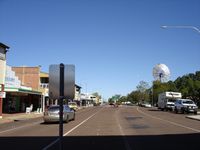
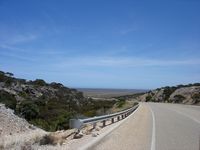
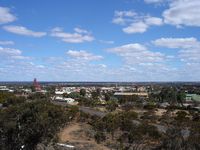
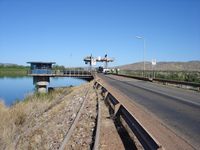
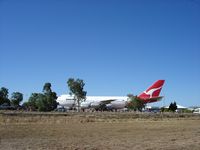
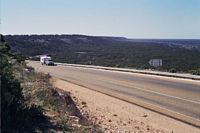
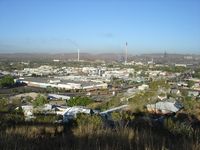
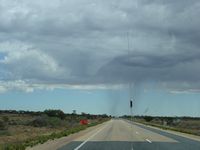
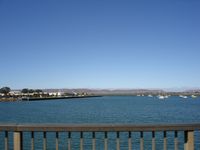
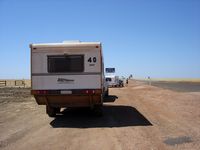
Here at Copeland in New South Wales a rural community allow campers on the village common for up to one month.